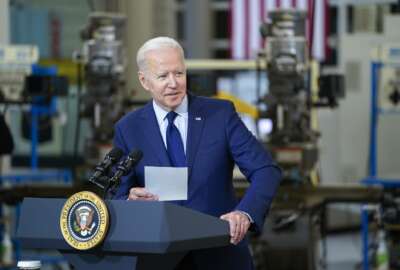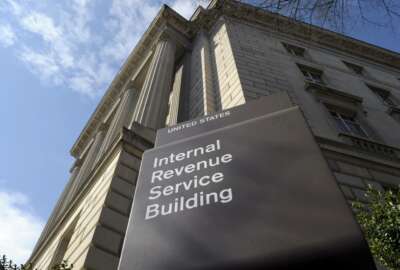
With Biden’s 2022 budget, civilian agencies are due for a hiring spree
Civilian agencies that saw their workforces decline or, in some cases, relocate, could experience hiring sprees if the Biden administration gets its way with its...
Several agencies that saw their staffs shrink or, in some cases, relocate during the previous administration are all due for large budget and workforce increases under the president’s 2022 request.
All told, the Biden administration has called for a 16% boost in discretionary spending at civilian agencies in 2022 over the previous year in an effort to “rebuild capacity,” a phrase the White House used on multiple occasions in its budget request, which it released last Friday.
Not all agencies will experience staffing surges under the president’s budget.
The Commerce Department will see a 7.4% workforce reduction after it staffed up last year to administer and prepare the 2020 Census.
Funding and workforce levels are relatively flat for the Department of Homeland Security, although some individual DHS components such as FEMA and Citizenship and Immigration Services would see more significant increases in staffing.
Interior reviewing BLM relocation
The Interior Department, for example, could receive a 17% boost in discretionary funding over the previous year. Biden’s 2022 budget supports an Interior workforce of 67,026 full-time employees, a 10.7% increase over 2020 staffing levels, according to the department’s request.
Staffing fell by 6.7% over the last four years, and workforce levels are supposed to level off to the point they were in 2018, Interior said.
At the Bureau of Land Management, staffing is expected to increase 12.3% in 2022 over 2020 levels, Interior said.
The department is actively reviewing the Bureau of Land Management relocation, which moved the BLM headquarters to Grand Junction, Colorado, and scattered other employees to new regions out west.
“The ongoing review focuses on understanding what impacts the reorganization has had on BLM operations and employees, assessing the impact of the significant loss of experience, and identifying needed actions to improve bureau capacity,” Interior’s budget request reads. “BLM plans to engage stakeholders — starting with bureau employees themselves — and evaluate options to provide responsive service to BLM’s customers in the west, coordinate with lawmakers and other partners in Washington, D.C., and ensure integrated leadership across the agency.”
More than 80% of the employees impacted by the previous administration’s BLM relocation did not move, Interior said.
The 2022 budget also includes $12.8 million for diversity, equity, inclusion and accessibility initiatives for the Interior workforce.
The Agriculture Department also experienced staffing losses in recent years, particularly at the Economic Research Service (ERS) and National Institute of Food and Agriculture (NIFA), both USDA bureaus that experienced their own relocation during the last administration.
Notably the USDA budget suggests the department will fill those staffing gaps within 2021, with ERS and NIFA workforce levels staying flat the following year.
All told, the Biden administration projects a 3.7% increase to the size of its workforce in 2022, with staffing increases at the Agricultural Research Service, Office of Rural Development and Food and Nutrition Service.
The USDA secretary’s office would see its own staffing boosts, including the chief information officer and the department’s budget office, where contractors filled in staffing gaps in recent years, according to the department’s 2022 proposal.
More resources for agency research and development
The Environmental Protection Agency could experience one of the largest staffing boosts, at least proportionally speaking, under the president’s 2022 budget.
The administration proposed a 7.4% staffing increase at EPA. The request includes funding for an additional 1,026 employees, which the agency said would help rebuild the workforces at EPA’s regional and headquarters offices.
More than 100 new hires would expand EPA’s research programs, while 86 new employees would support the agency’s criminal and civil enforcement programs, according to its 2022 request.
Nearly one-third of the EPA workforce is eligible to retire today or in the next year, and more than 43% are retirement eligible in the next five years.
“To address this potential shortfall and loss of institutional knowledge, the fiscal 2022 request focuses on immediate action to bolster the EPA workforce and build capacity by facilitating knowledge transfer and planning for the environmental and human health challenges of the future,” the agency’s request reads.
To recruit more young talent, EPA wants to expand its Title 42 hiring authority and is investing more people and dollars in its acquisition management program, the agency said.
Other agencies could see staffing boosts as the Biden administration emphasizes research and development.
The administration estimated a 4% staffing increase at the Department of Health and Human Services in 2022.
The administration projects staffing increases of a few hundred additional employees each for the Food and Drug Administration, Centers for Disease Control and Prevention, Health Resources and Services Administration and Indian Health Service.
CDC, for example, could see the largest discretionary budget increase in nearly 20 years, the Biden administration said.
The National Institutes of Health could see a $9 billion funding boost under Biden’s 2022 budget. Much of the increase would cover the initial launch of the new Advanced Research Projects Agency for Health, known as ARPA-H.
“With an initial focus on cancer and other diseases such as diabetes and Alzheimer’s, this major investment in federal research and development would drive transformational innovation in health research and speed application and implementation of health breakthroughs,” the administration said.
Like other agencies, the Department of Housing and Urban Development is due for its own hiring spree. Concerted efforts to add more staff after two decades of workforce declines will continue in 2022, the department said.
HUD began initiatives to fill staffing gaps back in 2019 and has steadily added more employees. The department’s enterprise risk management initiative revealed operational and programmatic vulnerabilities due to staffing declines, HUD said.
The Biden administration projects an increase of nearly 800 employees, or a 9.6% bump in the size of the HUD workforce next year.
“Using workforce succession strategies, the department intends to execute this increase to ensure that additional staffing results in the right people allocated to the right jobs, providing the biggest impact toward achieving HUD’s priorities,” the agency’s 2022 budget request reads.
Copyright © 2025 Federal News Network. All rights reserved. This website is not intended for users located within the European Economic Area.
Nicole Ogrysko is a reporter for Federal News Network focusing on the federal workforce and federal pay and benefits.
Follow @nogryskoWFED
Related Stories






